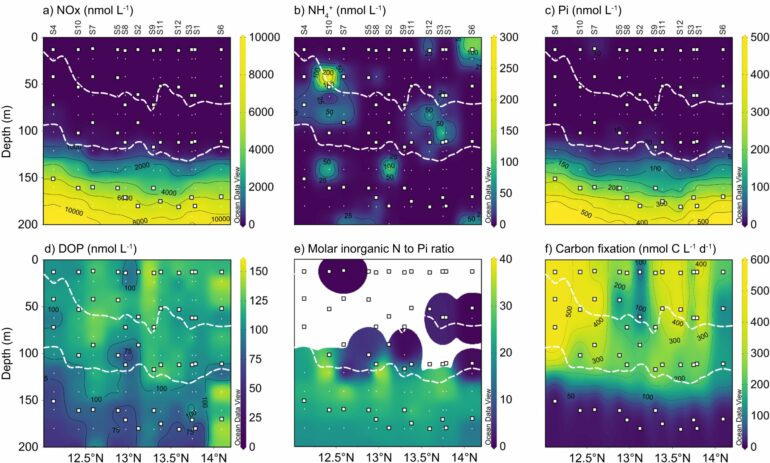Off Barbados, researchers from Bremen have investigated how bacteria inadvertently release methane in order to obtain phosphorus—with significant effects on atmospheric greenhouse gases.
The potent greenhouse gas methane constantly escapes from the sea into the atmosphere and contributes significantly to global warming. Methane is mainly produced by microorganisms and mostly in places where there is no oxygen. A few years ago, however, researchers demonstrated that bacteria are capable of so-called aerobic methane production.
These bacteria produce methane as a waste product during the acquisition of phosphorus, a nutrient that is crucial for survival and extremely rare in the sea. With the help of special enzymes, the bacteria can release phosphorus from organic compounds, such as methylphosphonate. Importantly, these enzymes also function in the presence of oxygen, for example in the surface waters.
Study in the tropical Atlantic: Spread far below the water surface
The distribution and significance of these bacteria and their abilities are still poorly researched or understood. Researchers from the Max Planck Institute for Marine Microbiology in Bremen have now published a study in Nature Communications in which they investigate bacterial methane production in the surface water off the Caribbean island of Barbados. There is plenty of oxygen and little phosphorus in the water there.
“So far, this process has only been studied in a few regions, mainly in the Pacific,” explains first author Jan von Arx. “We have now examined it for the first time in the western tropical North Atlantic.” The researchers show that methane production is highest near the water surface.
“But we were also able to detect methane at depths of up to 200 meters, even though at these depths there is actually enough phosphate and the bacteria wouldn’t need to use methylphosphonate,” says senior author Jana Milucka, head of the Greenhouse Gases Research Group at the Max Planck Institute in Bremen.
In addition, the types of bacteria that produce methane despite oxygen being present also change with depth: While the cyanobacterium Trichodesmium, a well-known and widespread marine primary producer, dominated methane production at the surface, so-called Alphaproteobacteria were predominant at greater depths.
Carbon from the atmosphere: Give and take
By using the otherwise unavailable phosphorus source methylphosphonate, it is possible for the bacteria to fix more carbon in the surface water than if they were dependent on phosphate alone. “According to our calculations, the bacteria can cover around a tenth of their phosphorus requirements from methylphosphonate,” says von Arx.
“This allows them to remove significant amounts of carbon dioxide from the atmosphere in this region. This clearly underlines the ecological importance of phosphonates in the carbon cycle of nutrient-poor ocean regions.”
The microorganisms capture carbon dioxide, but they also release the much more potent greenhouse gas methane. “Our study shows high methane production in the oxygen-saturated water column—something that was long considered impossible, but is now increasingly being observed,” says Milucka.
“Since the bacteria involved are found in all the world’s oceans, the methane produced from methylphosphonate probably contributes significantly to the release of this greenhouse gas from the sea, especially in phosphate-poor environments.”
Is increased methane release due to climate change?
How much methane is released into the environment depends on the ratio of its production and oxidation. “However, we still don’t have a clear overview of where the methane in the ocean comes from and how it disappears. We also don’t know how these so-called sources and sinks of methane in the ocean will react to the ongoing climate change,” explains Milucka.
“We suspect that aerobic methane production will increase in the future, as phosphate will become even scarcer due to the warming of the ocean and the resulting stronger stratification of the water column. This is problematic because this process takes place in surface waters and therefore the methane produced in this way can immediately escape into the atmosphere,” adds von Arx.
In order to be able to predict future changes in the release of climate-relevant gases, the processes involved and the determining factors must be researched further. “If we understand how a process works, we have a better chance of predicting and/or counteracting its negative effects,” concludes von Arx.
More information:
Jan N. von Arx et al, Methylphosphonate-driven methane formation and its link to primary production in the oligotrophic North Atlantic, Nature Communications (2023). DOI: 10.1038/s41467-023-42304-4
Provided by
Max Planck Society
Citation:
Study finds bacteria use organic phosphorus and release methane in the process (2023, November 8)



